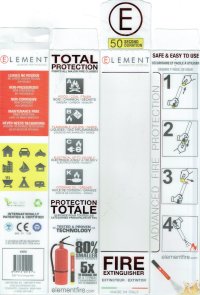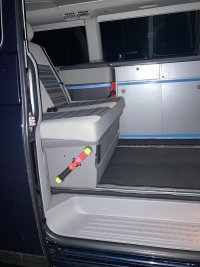R_Sargeant_CH
Hi all,
I searched the forum but it seemed no-one has fully answered all my questions, so here's the results of my research and purchase. I must point out that I am in no way an expert on fires, so please do not take anything you read here as Gospel - decide for yourselves!
My wife and I fly hot-air balloons. Sitting a few thousand feet in the air in a combustible basket together with 4 tanks full of liquid propane makes you think a bit about fire extinguishers so when we bought our California, definitely on the list!
Common sense first. If there's a fire, get everyone out! Your insurance will pay for a new Van (which you lusted after anyway)! Fight the fire from outside the van.
From previous experiences, there are three problems with conventional extinguishers.
1) They are very heavy chunks of steel that you do not want flying around if you are involved in an accident.
2) They are "lifed", and need servicing/replacing after a few years.
3) They apparently make a total mess that is sometimes corrosive, so you might as well write off the Van anyway!
4) They are bulky and heavy and mounting them securely and not in the way is a challenge in a California, where every item has to justify the room it takes.
Stick type extinguishers seemed to be a possible solution.
Armed with Google and YouTube, I found Element sticks. These are available as either 50 second or 100 second versions. Other manufacturers last much less long and are around the same price.
I couldn't find a European supplier, but once my US-ordered unit arrived at our home in Switzerland and I saw it was manufactured in Italy, I was able to backtrack and find UK and worldwide suppliers. I've attached a picture of the packaging from my unit. UK units may have different packaging - this is a US unit imported from Canada (go figure), but all units I have seen have "ELEMENT" wrote large on the actual stick, are half red, half black and have yellow caps at each end.
1) These units weigh about 200g. Diameter 35mm, length 260mm. Think Running Baton size.
2) There is no mention of "Life" on the extinguisher. The propaganda on the UK site says "No servicing or maintenance, 15 year shelf life, no expiry date (?)", so I can be reasonably confident it's going to work in 6-7 years time, unlike conventional extinguishers.
3) These apparantly leave no mess. The products of use combined with a fire are a small amount of Potassium and water vapour.
4) Very small and light. Supplied with a robust plastic clip that I plan to bolt to the steel base of a seat, where it's easily accessable but not in the way.
Almost forgot, the blurb on the extinguisher says "Class A, B, C & K fires". Class B is what you need for Butane/Propane/Petrol fires. "K" is for your chip pan fires! (Chip pans in a Cali)?
This type of extinguisher apparently "eats" Oxygen, which and fire needs and thus kills the fire. One review I saw said that in an enclosed space like a van, the best procedure is to get everyone out, light the device, place it inside the van and close the doors, leaving the stick to do its work.
We have the 50 second version, there's also a 100 second variant. Ours cost the equivalent of £70 but we sourced ours from the US so I would think the UK suppliers above would be cheaper.
Lastly, we also have a fire blanket. Also small, easy to mount and cheap. We also use ours if we're barbecuing and there's and risk of scorching the ground underneath. They are easily refolded and a few charcol marks don't matter.
I hope this is helpful - and that you never need it!
Greetings from Switzerland!

I searched the forum but it seemed no-one has fully answered all my questions, so here's the results of my research and purchase. I must point out that I am in no way an expert on fires, so please do not take anything you read here as Gospel - decide for yourselves!
My wife and I fly hot-air balloons. Sitting a few thousand feet in the air in a combustible basket together with 4 tanks full of liquid propane makes you think a bit about fire extinguishers so when we bought our California, definitely on the list!
Common sense first. If there's a fire, get everyone out! Your insurance will pay for a new Van (which you lusted after anyway)! Fight the fire from outside the van.
From previous experiences, there are three problems with conventional extinguishers.
1) They are very heavy chunks of steel that you do not want flying around if you are involved in an accident.
2) They are "lifed", and need servicing/replacing after a few years.
3) They apparently make a total mess that is sometimes corrosive, so you might as well write off the Van anyway!
4) They are bulky and heavy and mounting them securely and not in the way is a challenge in a California, where every item has to justify the room it takes.
Stick type extinguishers seemed to be a possible solution.
Armed with Google and YouTube, I found Element sticks. These are available as either 50 second or 100 second versions. Other manufacturers last much less long and are around the same price.
I couldn't find a European supplier, but once my US-ordered unit arrived at our home in Switzerland and I saw it was manufactured in Italy, I was able to backtrack and find UK and worldwide suppliers. I've attached a picture of the packaging from my unit. UK units may have different packaging - this is a US unit imported from Canada (go figure), but all units I have seen have "ELEMENT" wrote large on the actual stick, are half red, half black and have yellow caps at each end.
1) These units weigh about 200g. Diameter 35mm, length 260mm. Think Running Baton size.
2) There is no mention of "Life" on the extinguisher. The propaganda on the UK site says "No servicing or maintenance, 15 year shelf life, no expiry date (?)", so I can be reasonably confident it's going to work in 6-7 years time, unlike conventional extinguishers.
3) These apparantly leave no mess. The products of use combined with a fire are a small amount of Potassium and water vapour.
4) Very small and light. Supplied with a robust plastic clip that I plan to bolt to the steel base of a seat, where it's easily accessable but not in the way.
Almost forgot, the blurb on the extinguisher says "Class A, B, C & K fires". Class B is what you need for Butane/Propane/Petrol fires. "K" is for your chip pan fires! (Chip pans in a Cali)?
This type of extinguisher apparently "eats" Oxygen, which and fire needs and thus kills the fire. One review I saw said that in an enclosed space like a van, the best procedure is to get everyone out, light the device, place it inside the van and close the doors, leaving the stick to do its work.
We have the 50 second version, there's also a 100 second variant. Ours cost the equivalent of £70 but we sourced ours from the US so I would think the UK suppliers above would be cheaper.
Lastly, we also have a fire blanket. Also small, easy to mount and cheap. We also use ours if we're barbecuing and there's and risk of scorching the ground underneath. They are easily refolded and a few charcol marks don't matter.
I hope this is helpful - and that you never need it!
Greetings from Switzerland!

Last edited:














